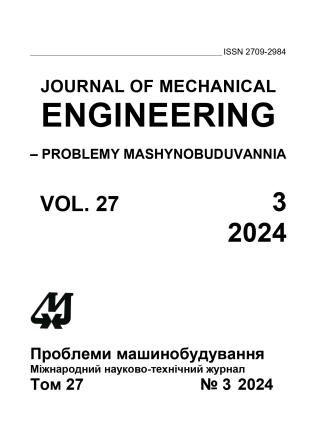Discretization of Thin-Walled Sections with Variable Wall Thickness
Abstract
At the stage of designing thin-walled aircraft structures, to simplify calculations, their cross sections are idealized. To do this, the section with the skin and the longitudinal elements reinforcing it is replaced (when determining normal stresses) by a discrete one, consisting of concentrated areas at characteristic points. In this case, the equality of the moments of inertia of the initial and discrete sections is preserved. Such idealization is used in the calculation of thin-walled rods for normal and shear stresses (Wagner model). For sections consisting of a system of rectangular strips of constant thickness, discretization allows to set approximate values of normal and shear stresses and accurately find the locations of the singular points of the bending center (in an open contour) and the center of rigidity (in a closed one). The discrete model of a strip consists of three lumped areas: two at the edges and one in the center. The paper proposes to extend the discrete model to sections in which the skin thickness changes according to a linear law. In addition to the rectangular strip, it is possible to use elongated triangles and trapezoids, replaced by three and four concentrated areas, respectively. The possibility of using a discrete model for calculating some thin-walled sections of open and closed contours is considered. The section of an open contour is studied - the problem of transverse bending without torsion of a channel having flanges with a linearly variable thickness. Differences in the flows of tangential forces calculated from the exact and discrete models are shown. The coincidence of the results in determining the position of the bending center according to two models was established. When studying the application of a discrete model to a closed contour, its simplified option is proposed. The problem of transverse bending without torsion and finding the center of rigidity in a section with a contour line in the form of a trapezoid with front and rear walls of constant thickness and upper and lower skins and a similar section with a contour in the form of a rectangle was considered. Differences in the flows of tangential forces calculated by exact and discrete models are established. For a closed section in the form of a rectangle, the decrease in the moment of inertia for torsion due to the redistribution of material in the cross section was studied separately. It has been established that when finding the position of the center of rigidity, the discrepancy between the results of the exact and discrete models in sections with geometric parameters close to real ones was less than 1% for a rectangular contour, and 4% for a trapezoidal contour. The results indicate the possibility of extending the application of the discrete model of thin-walled cross section to the design calculations of thin-walled rods with variable skin thickness, representing practical structures.
Downloads
Published
Issue
Section
License
Copyright (c) 2024 М. М. Гребенніков, О. Г. Дібір, А. О. Кирпікін

This work is licensed under a Creative Commons Attribution-NoDerivatives 4.0 International License.
All authors agree with the following conditions:
- The authors reserve the right to claim authorship of their work and transfer to the journal the right of first publication of the work under the license agreement (the agreement).
- Authors have a right to conclude independently additional agreement on non-exclusive spreading the work in the form in which it was published by the jpurnal (for example, to place the work in institution repository or to publish as a part of a monograph), providing a link to the first publication of the work in this journal.
- Journal policy allows authors to place the manuscript in the Internet (for example, in the institution repository or on a personal web sites) both before its submission to the editorial board and during its editorial processing, as this ensures the productive scientific discussion and impact positively on the efficiency and dynamics of citation of published work (see The Effect of Open Access).

